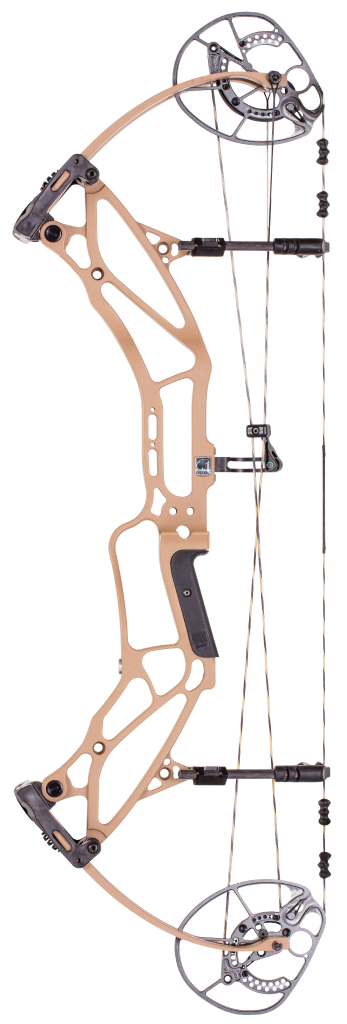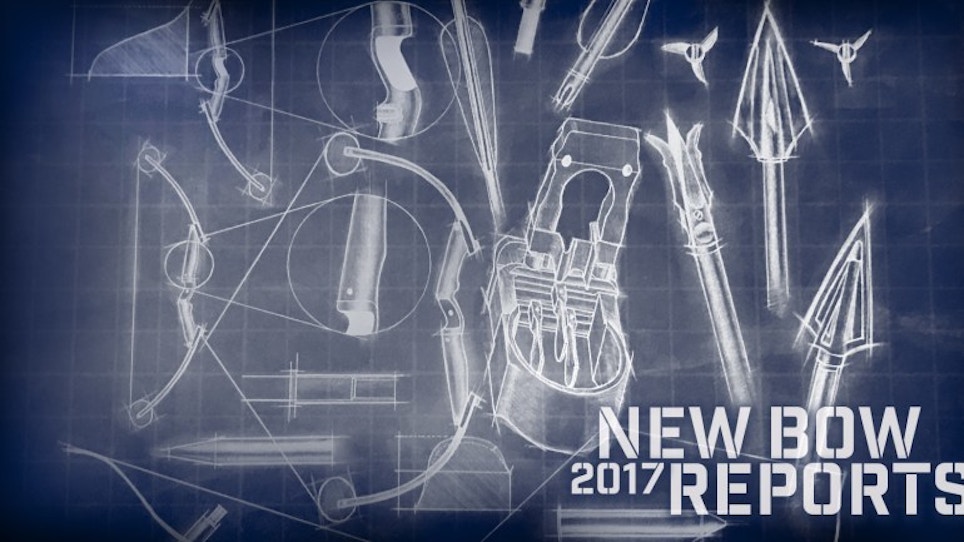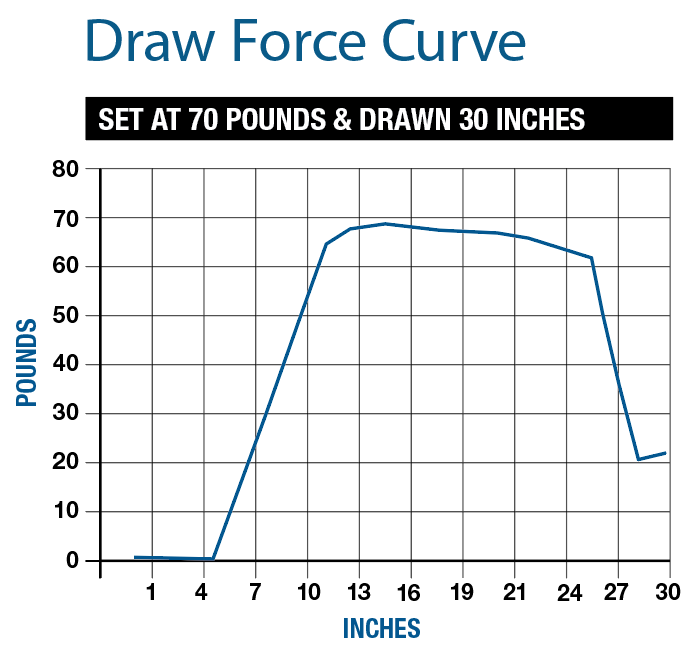 Most bow manufacturers claim to produce bows that are very fast and very shootable. In fact, the designers of the more successful companies — Bear being one of them — have done a remarkable job in recent years of finding that sweet spot between bows that are fast by current standards while still being smooth-drawing, shock-free, quiet, easy-tuning and generally pleasant to shoot. That being said, there are still many shooters who lean toward the fastest end of the spectrum and will accept a little less in the way of shootability to get it, as well as those who lean toward maximum shootability and place less value on speed.
Most bow manufacturers claim to produce bows that are very fast and very shootable. In fact, the designers of the more successful companies — Bear being one of them — have done a remarkable job in recent years of finding that sweet spot between bows that are fast by current standards while still being smooth-drawing, shock-free, quiet, easy-tuning and generally pleasant to shoot. That being said, there are still many shooters who lean toward the fastest end of the spectrum and will accept a little less in the way of shootability to get it, as well as those who lean toward maximum shootability and place less value on speed.
The LS-6 is Bear’s 2017 flagship. It’s the fastest bow in the Bear lineup and, at a sizzling 355 fps, is clearly aimed at shooters who lean toward the speed end of the spectrum. It’s one of four bows in the Legend series. (Though with different cams, different risers and different limbs, it’s difficult to see what makes the collection a “series.”)
At a glance, the bridged riser distinguishes it from every other Bear bow. The bridge aside, the geometry of this riser is unlike any Bear has offered in the past. While the new H17 Hybrid Cams feature the familiar large size and the adjustable modules of Bear’s previous products, they are aggressively flat-sided. Less obvious, but still significant, is the new Narogrip, which is somewhat flattened at the back and is, as the name suggests, very skinny. Also skinny — especially so for a Bear bow — is the brace height, which at 5 inches is skinny by any standard. Finally, although it’s not visible, another distinguishing factor of this bow is the 70 percent letoff, especially noteworthy given the recent trend toward 80 percent and even higher letoffs.
Bear’s Max-Preload Quad Limbs are now familiar. Back from last year are the limb pockets with high-strength barrel nuts, the torque-reducing Hinge Guard cable-guard system and the SonicStop Offset Strings Supressors.
Appearance being subjective, some will no doubt like this different look for Bear, and others will not. The limb pockets that were introduced last year lend a subtly more streamlined look. (You don’t notice those knobby limb bolts protruding until you see a bow without them.) Fit and finish are, as you’d expect from a Bear flagship model, excellent.
Specs:
- Letoff: 70 percent
- Brace height: 5 inches
- Weight: 4.2 pounds
- Axle-to-axle length: 32.25 inches
- Speed: 355 FPS
- Draw weights: 45-60 or 55-70 pounds
- Draw lengths: 27 to 30 inches, adjustable in half-inch
- increments, no press or additional modules required
- Options: Realtree Xtra Green, Shadow, Brown, Olive
- Suggested retail: $900
Shooting the Bow
Tolerances are generally tight on Bear bows, as evidenced by secure but smoothly turning limb bolts and accessories that install easily without fear of stripping any threads. Tuning Bear bows is typically easy, and the LS-6 was no exception. I’ve commented before on the Bear design that enables the shooter to place an arrow against the riser then adjust the rest so that an arrow on the rest is parallel to that against the riser for its entire length. It’s a great system that’s not only easier, but also more precise than attempting to measure eighths or sixteenths of an inch from the riser to the center of the arrow shaft, and it generally results in excellent arrow flight without further tinkering. I still like to paper tune to get the best flight for broadheads, and, in this case, it took all of two minor adjustments to get bullet holes through paper.
The real question for a bow as fast as the LS-6 is the extent to which the various design elements that produce higher speeds — an inch shaved off the brace height, a slightly more aggressive cam, decreased letoff, a shortened valley — affect shootability. The draw cycle of the LS-6 is certainly smooth in the sense that there are no bumps or humps and no sudden drop-off into the valley that wrenches the arm against the back wall. The draw force curves indicate that pull at peak weight declines gradually. In fact, it appears almost flat. But since greater effort is required as the arm is drawn further back, the perception is one of building steadily to a peak, then dropping off quickly (but not suddenly) into a shallow valley. I did not find the bow “grabby,” but that perception is somewhat subjective. Those who stretch their draw length slightly beyond optimum, prefer a very high letoff, tend to hold at full draw for extended periods or do not tend to pull through the shot will always prefer a wide valley over a narrow one. Similar factors apply to the skinny brace height. Depending on shooting form (and in some cases just plain anatomy), a skinny brace height may or may not be problematic. I can find no real evidence for the old notion that a wider brace height is more forgiving. It is true, though, that loose sleeves or very heavy clothing can increase the chances of wrist slap with lower brace heights, especially if some sort of wrist or armguard is not worn.
The 70 percent letoff will be noticeable to anyone accustomed to 80 percent or higher letoff. Whether or not a shooter finds it objectionable depends on subjective factors such as how close to his or her maximum draw weight he or she tends to shoot, conditioning, proper draw length and just plain personal preference. (The case can be made that a lower letoff promotes better shooting form, a more stable hold at full draw and a better release.)
The speed of this bow is evident when shooting. The bow pops forward into the hand at the release with very little perceptible vibration and a relatively quiet shot. The grip is new for Bear and noticeably narrower. It is not a soft grip, but it isn’t uncomfortable, and, to the extent a grip can promote repeatability and reduce torque, this one does. I found the bow pleasant to shoot. In the final analysis, it achieves exactly what I suspect the folks at Bear wanted it to. Shooters who demand bows with high letoff, deep valleys, wide brace heights and the easiest possible draw cycle will look at other models. With the LS-6, Bear expands its lineup to provide an option for those shooters who like a bow that is comfortable to shoot, but appreciate the feel and the advantages to be offered by a truly high-performance bow.
For more information, visit www.beararchery.com.








